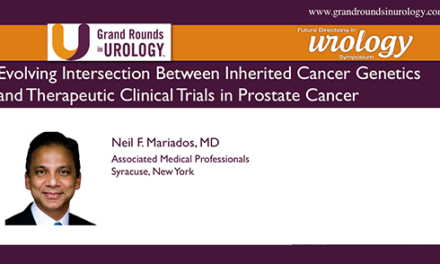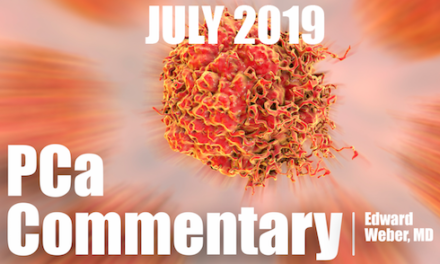
PCa Commentary | Volume 126 – September 2018
Posted by Edward Weber | September 2018
ESTROGEN — OUR SISTER HORMONE:
Addressing the Dark Side of Androgen Deprivation Therapy (ADT)
Many of the important adverse effects associated with androgen suppression with Lupron, Firmagon, or orchiectomy result from estrogen deficiency. Estimates vary, but 50%, 75%, or as much as 80% of a man’s serum estrogen arises from enzymatic conversion of serum testosterone. And when ADT drops serum testosterone into the low range of 20 – 30 ng/dL, a profound estrogen deficiency results. Loss of muscle strength and muscle mass, and erectile dysfunction can be directly attributed to diminished testosterone (T). However, estrogen deficiency is largely responsible for hot flushes (experienced by ~70-80% of men on ADT), loss of libido, osteoporosis and associated fracture risk, elevation of serum lipids, increased cardiovascular risk, increased fat deposition and weight gain, increased insulin resistance and diabetes, and, arguably, memory loss.
The thrust of current studies is to devise treatments that control prostate cancer while at the same time maintaining a normal male estrogen level so as to avert these adverse effects.
HOW COULD THIS BE ACCOMPLISHED?
Two current strategies:
- Supplementation of ADT with “add-back” low-dose transdermal estrogen is a strategy designed to return male estrogen levels to normal while maintaining castrate T levels with traditional LHRH inhibition.
- Employing high-dose transdermal estrogen as a single agent to achieve castrate T and gain the beneficial effects of estrogen. This regimen is under study in the ongoing randomized phase III trial, “Prostate Adenocarcinoma Transcutaneous Hormones (PATCH) (NCT00303784),” currently under study in the United Kingdom.
A (LITTLE) BIT OF BASIC SCIENCE:
A natural question is how exogenous (transdermal) estrogen achieves castrate levels of testosterone. Estrogen achieves this via a negative feedback loop which turns off pituitary luteinizing hormone (LH) whose function is to promote testosterone production in the testes — the same general mechanism utilized by the LHRH inhibitors. Transdermal estrogen patches contain estradiol (E2), the most biologically relevant of the three subtypes of estrogen. In the PATCH trial, early results recorded that T was reduced at 30 months to <50 ng/dL in 96% of men in both the LHRH agonist and the E2 patch cohorts and remained similar at 6 months.
Earlier studies using oral estrogens were associated with significant cardiovascular adverse effects due to the induction of clotting factors in the liver. By utilizing the transcutaneous route, this hepatic “first-pass” metabolism is bypassed and the adverse effects averted.
Just as prostate cells have the all-important androgen receptor (the target for testosterone and dihydrotestosterone), similarly they contain receptors for estrogen which are activated by estradiol (E2): i.e. the estrogen receptors ER alpha and ER beta. ER beta is considered a tumor suppressor while ER alpha serves to promote prostate cell proliferation and possibly carcinogenesis. However, clinical studies have not demonstrated this consequence. The PATCH trial, however, will closely monitor for this.
A WORD ABOUT MALE ESTROGEN LEVELS:
Men’s serum estrogen levels decrease with age and levels vary considerably among men of the same age.
The average E2 level in men 65 – 85 years old is ~86 pmol/L with a range of 23 to 160 pmol/L (the preferred unit for this measurement). For perspective, as will be noted below, the low-dose E2 patch used in the “add-on” regimen raises the E2 level to a mean of ~208 pmol/L (interquartile range 157-332). The higher E2 dose used in the PATCH trial raises E2 to ~685 pmol/L (range from 1400-4500).
A study by Russell (2018, see below) recorded that ADT lowers men’s E2 levels to ~11 pmol/L.
In his 2017 study he noted that it requires E2 levels above 40 pmol/L to sustain bone health and libido, above 70 pmol/L to avoid gain in body fat and maintain insulin sensitivity, and greater than 90 pmol/L to prevent hot flushes.
REVIEW OF THE E2 ‘ADD-BACK’ STUDY — WHAT WERE THE RESULTS?
TITLE: “Short-term effects of transdermal estradiol in men undergoing androgen deprivation therapy for prostate cancer: A randomized trial,” Russell et al. Eur Soc Endocrinology, Mar 2018.
In this small study, 37 men with nonmetastatic CRPC were randomized between the daily application of 1 mL of E2 gel (0.9 mg) vs. a placebo and were evaluated at 28 days for hot flush frequency and biomarkers of bone resorption and insulin resistance. The baseline median T was
6 ng/dL; baseline E2, 11 pmol/L.
Findings:
- 76% of men (16/21) found the treatment helpful in reducing hot flushes. “This benefit effect occurred despite not selecting men for troublesome hot flushing” (23% of men on placebo found the treatment helpful). Evidence of bone resorption decreased significantly. Nipple tenderness was seen in 17% in the E2 group.
In another study, “Transdermal Estrogen in the Treatment of Hot Flushes in Men with Prostate Cancer,” hot flushes were reduced in men using transdermal patches during ADT (Gerber et al. Urology, Jan 2000):
In the Gerber study two patch doses were used: 0.05 mg or 0.10 mg of estradiol twice weekly. The higher dose reduced hot flush frequency significantly. Overall, 83% of men experienced benefit to any extent. Nipple tenderness occurred in 12% and 42% at the two doses. Estradiol increased from 44.4 pmol/L (baseline) to 60.0 and 98.8 pmol/L. The transdermal patch formulation utilized was “Estraderm,” Novartis Pharmaceuticals.
THE PATCH TRIAL: TRANSDERMAL E2 AS A POTENTIAL ALTERNATIVE TO LHRH INHIBITION (NCT00303784) — EARLY RESULTS:
(Langley et al., “A Randomized Comparison Evaluating Changes in Bone Mineral Density in Advanced Prostate Cancer: Luteinizing Hormone-releasing Hormone Agonist Versus Transdermal Oestradiol,” Eur Urol. 2016.
Changes in bone density and cardiovascular safety issues were reported at 2-yr follow-up. DEXA bone scans evaluated bone density at baseline, 1 and 2 years. The ultimate long-term trial goal is assessment of safety and progression-free and overall survival in a target cohort of 2150 men.
In the study, 74 men with locally advanced or metastatic cancer in whom long-term ADT was planned were randomized between an LHRH inhibitor or transdermal E2 patches (0.1 mg/24 hrs changed twice/wk). Both regimens achieved similar castrate T levels.
Findings:
- At 2 years, for those men remaining in the study (n=48) the lumbar spine bone mineral density mean percentage change for LHRH agonist group was -3.0%. [Various studies report a range of decrease of 5 – 10%.] For men on E2 patches there was +7.9% gain in bone density.
- In an initial cohort of 254 men at 19 mo follow-up “the proportion of patients in the E2 arm experiencing a cardiovascular system event (10.1%) was relatively similar to that in the LHRH agonist arm (7.1%), “with half of the events assigned to men on E2 occurring sometime after treatment with patches was stopped and LHRHa started.”
- Gynecomastia occurred in 75% of men on E2, but was generally mild. It is seen in ~19% of men on LHRH inhibitors.
- Hot flushes were reported in 25% of men on E2, whereas flushes occurred in 54% on the LHRH agonists.
Editorial Comment:
The longer-term data on progression-free and overall survival in the PATCH trial have the potential of providing a new option for ADT that avoids many (but not all) of the well-recognized side effects of Lupron, Degarelix and orchiectomy. In the initial 2 year period, clear clinical benefits were seen and a satisfactory short-term safety profile was demonstrated — especially the lack of adverse cardiovascular events. Long-term safety is a requisite.
In current clinical practice, the “add-on” regimen offers benefits. It might be a useful treatment for men with troublesome hot flushes. Ideally, before starting ADT all men would be well served by a pre-treatment DEXA scan. Those men with osteopenia (diminished bone density) or frank osteoporosis would be excellent candidates for “add-on” E2.
Dosage guidelines for transdermal E2 in males have not been established, but a reasonable plan was suggested in the Gerber article (see above): start with the low dose patch of 0.05 mg 2X/wk and increase to 0.10 if needed.
BOTTOM LINE:
The “add-on” regimen – E2 patch plus ADT — can be beneficial to men with troublesome hot flushes and those at risk for deterioration of bone density. The PATCH study at 2 years follow-up has demonstrated safety and effectiveness comparable to LHRH inhibition, and if confirmed in long-term analysis, transdermal E2 as a single agent will offer an additional option for ADT.
Your comments and requests for information on a specific topic are welcome e-mail ecweber@nwlink.com. Please also visit https://prostatecancerfree.org/prostate-cancer-news for a selection of past issues of the PCa Commentary covering a variety of topics.
“I want to thank Dawn Scott, Staffperson, Tumor Institute Radiation Oncology Group, & Mike Scully, Librarian, Swedish Medical Center for their unfailing, timely, and resourceful support of the Commentary project. Without their help this Commentary would not be possible.”
ABOUT THE AUTHOR
Edward Weber, MD, is a retired medical oncologist living in Seattle, Washington. He was born and raised in a suburb of Reading, Pennsylvania. After graduating from Princeton University in 1956 with a BA in History, Dr. Weber attended medical school at the University of Pennsylvania. His internship training took place at the University of Vermont in Burlington.
A tour of service as a Naval Flight Surgeon positioned him on Whidbey Island, Washington, and this introduction to the Pacific Northwest ultimately proved irresistible. Following naval service, he received postgraduate training in internal medicine in Philadelphia at the Pennsylvania Hospital and then pursued a fellowship in hematology and oncology at the University of Washington.
His career in medical oncology was at the Tumor Institute of the Swedish Hospital in Seattle where his practice focused largely on the treatment of patients experiencing lung, breast, colon, and genitourinary cancer and malignant lymphoma.
Toward the end of his career, he developed a particular concentration on the treatment of prostate cancer. Since retirement in 2002, he has authored the PCa Commentary, published by the Prostate Cancer Treatment Research Foundation, an analysis of new developments in the prostate cancer field with essays discussing and evaluating treatment management options in this disease. He is a regular speaker at various prostate cancer support groups around Seattle.





